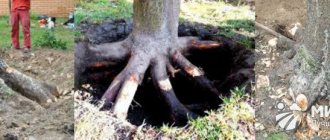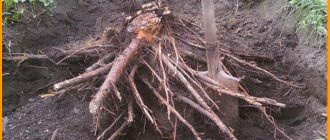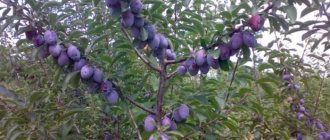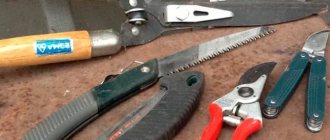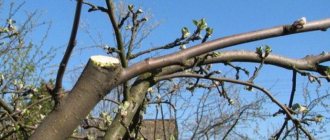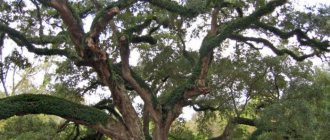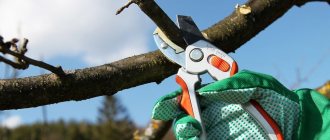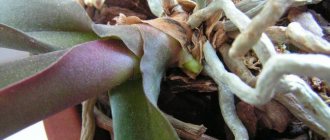Why does a tree form shoots?
The plant wants to leave offspring because it feels a threat to its existence. Preserving the genus is one of the most powerful defense mechanisms in cultures. When conditions are unfavorable for growth or when an old plant begins to “understand” that it is reaching the end of its life span, fresh shoots begin to form.
The main reasons why growth appears:
- Great age of culture.
- The appearance of pests on the tree.
- Incorrect feeding or lack thereof.
- Roots underground are rotting or damaged.
- Long dry period, lack of watering.
- Overdone with pruning. A signal for concern in a plant is cutting off a large part of the crown.
- If the shoots grow quickly and luxuriantly, it means that not everything is as it should be with the crop. Understand the problem and take measures to prevent the shoots from forming further.
HOW TO GET RID OF GROWTH - VIDEO
Gardening tips: how to get rid of overgrowth – Morning – Inter
TOOLS FOR CRAFTSMAN AND CRAFTSMAN, AND HOUSEHOLD GOODS VERY CHEAP. FREE SHIPPING. THERE ARE REVIEWS.
Below are other entries on the topic “How to do it yourself - for a homeowner!”
- How to grow seedlings from shoots Is it possible to grow SEEDLINGS FROM...
- An effective way to get rid of wasps on grapes and fruit trees. Fighting wasps - the Invasion method...
- Grafting an apricot onto a plum shoot - scheme and result HOW TO GRAFTER AN APRICOT ON A Plum shoot...
- How to get rid of water accumulating in the cellar if the floor is sloped Water in the cellar - how...
- Pruning shrubs - table-memo for the gardener FEATURES OF Pruning SHRUBS - AGRONOMIST...
- Earwigs - how to get rid of them? HOW TO FIGHT EARwigs (AND...
- Condensation on windows - how to correct the situation and get rid of it? THE WINDOW IS “CRYING”: REASONS AND SOLUTIONS Maybe...
Subscribe to updates in our groups and share.
Let's be friends!
With your own hands › Summer cottage garden and vegetable garden › How to get rid of overgrowth: causes of appearance and removal
When to remove shoots and when not to?
The growth must be removed. The offspring connect with the roots of the older tree and accordingly share nutrients with them. As a result, the growth of the main plant will slow down. The tree is in no hurry to bloom and bear fruit, the berries and flowers become small, and the taste of the berries changes. Also, the growth takes up extra space on the site, which may give the impression that the dacha is completely unkempt.
The shoots are preserved only in one case - if it is desired for the plant to reproduce by offspring-roots.
Plum varieties without shoots
Regardless of the variety, plum trees produce shoots. However, they do this in different ways. In fruit growing, native plum species have been identified that produce a large number of wild shoots, for example:
- "Ochakovskaya yellow";
- "Common Hungarian";
- "Italian Hungarian";
- "Local red."
They produce dense and tall growth.
There are also self-rooted varieties of plums, which are distinguished by a low percentage of formation of root shoots. Let's consider the types of plum trees without shoots, these are:
- "Rencold Altana";
- "Stanley"
- "Anna Shpet"
In addition, these types of plums produce a rich harvest, and they are also resistant to the negative effects of the ecosystem.
Is it possible to use chemicals?
You can use herbicides that contain a substance that burns the crop along with the root system. It is generally accepted that such a drug is safe for older crops. Is it possible? After all, they have common roots! Naturally, the large plant will not die, but there will be harmful consequences for it.
Herbicides are suitable only if it is necessary to remove shoots with an older crop.
There is an opinion that using such chemicals is generally not recommended under any circumstances. If there are any fruit-bearing crops nearby, herbicides will become a danger to them. The wind will blow slightly, and the toxic substance will fall on the neighbor.
How to destroy the growth of trees on the site?
There are two ways to deal with this problem. The first is to destroy the bushes mechanically. The second is used if the area is very overgrown. To do this you will have to resort to the use of chemicals.
Using chemicals
Destruction of shoots is used if other methods are completely ineffective. This method should be used as a last resort, because during processing you can not only destroy the shoots, but also harm the tree itself.
After treatment, the substances included in the herbicides disintegrate in the soil and do not have a negative effect on the environment and plants growing nearby.
To destroy young shoots, it is best to use the amine salt 2,4-D. The solution is applied directly to the leaves. Butyl ether effectively fights the growth of fruit trees. The drugs Roundup, Tornado, and Glukor are also effective.
Mechanically
The safest method of removal is mechanical.
Features of destruction of shoots mechanically:
- Shoots should be removed as soon as they begin to appear, before they have time to get stronger.
- Cutting off the shoots with pruning shears will not be enough; you need to dig them up without separating them from the root system.
- You need to cut off the stems of the shoots as close to the base of the root as possible.
- After removing the shoots, the pruning areas should be lubricated with garden varnish to prevent them from starting to grow back.
For the procedure, sharply sharpened pruners are used so that there are no creases left after pruning the bark system from the mother tree. Also, after this, the soil around you can be scalded with boiling water so that the shoots do not begin to grow again.
For example, cherries have a very specific growth system. Even if you dig up a shoot with its roots, next year several more shoots will grow in its place. So you can dig up the shoots ad infinitum and not achieve any results.
See also
Composition of Alistair Granda and instructions for use of the herbicide, application ratesRead
You can get rid of shoots by cutting them off with pruning shears. Bushes are cut at a level of 30 cm from the soil. Thanks to this method, in a few years it will be possible to “wean” the cherry tree from producing a large amount of shoots.
Folk remedies
In addition to the use of chemicals and mechanical removal, folk remedies will come to the rescue. For example, you can plant a shady tree (chestnut or maple) nearby. These trees will prevent other plants from sprouting. To prevent shoots from appearing in this area, the soil is mulched with a thick layer of peat, sawdust or straw.
In order to prevent the appearance of unnecessary shoots, the root collar is buried generously with soil. Very often it is the exposure of the roots that leads to the active development of shoots.
How to do it correctly and safely
Arm yourself with a shovel if you want to effectively remove the growth with the least negative consequences for the well-being of the plant. Getting rid of shoots above the soil surface or a little lower is a waste of time: they will begin to grow even more intensely.
Use a shovel to dig out the growth to the base.
Then separate the shoots from the main root system. Fill the hole with soil. Create the necessary conditions and care for the crop. You will have to work hard, but you will remove the growth correctly and reduce the risk of its formation in the future.
On what trees does it occur?
The shoots can be found next to most fruit crops. But most often, young bushes begin to grow next to those trees that are weakened due to various factors. For example, due to temperature changes, lack or excess of nutrients in the soil. Or if these trees simply die off from old age.
Most often, this problem occurs when growing plums, cherries, lilacs, apple trees, cherry plums, poplars, and birches. These trees can cause a lot of trouble before you can successfully remove the growth from the site.
Reasons for the appearance of root shoots
Among garden plants there are many that are prone to the formation of root shoots: plum, cherry, raspberry. Sprouts from the roots can also appear in other trees. This signals their distress.
Diseases and damage to trees
This is the most common reason for the formation of shoots from the roots. Fungal and bacterial diseases, frost damage, and serious mechanical damage can destroy the tree. Unable to cope with these factors, the plant tries to survive itself and give life to a new generation in all ways available to it. Including producing root shoots.
In autumn and spring, treat the garden with iron sulfate; in summer - as needed. This will reduce the infectious background in the garden. Check your trees carefully every month. Clean the found wounds with a knife and treat them with a fungicide and antibacterial agent, and cover them thoroughly with garden varnish.
Poor garden layout
Sometimes the aesthetic preferences of the garden owner may not coincide with the needs of the plants. Light-loving trees are in the shade, and shade-tolerant trees are in the sun. By releasing root shoots, the plant signals discomfort and tries to “move” to a place with more suitable conditions.
When planting a garden, study what conditions the variety prefers. Plant bushes and trees in stages, focusing on the parts of the world and the degree of illumination of the area. Low-growing plants will feel better on the south side; tall plants will have enough light in the northern part of the garden. A staggered disembarkation option is possible.
If you have already made the above mistakes, there are two options to correct the situation. Thin out the branches of dense trees that shade neighboring trees. And more drastic: cut down the less necessary plants.
Insufficient watering
When there is little water, the roots tend to be closer to the surface. Having made their way to the moisture, they release shoots. This problem is solved by watering the soil around the entire perimeter of the crown. Young suction roots are furthest from the trunk.
Exposed roots
This problem occurs when the seedling is not buried correctly. The solution is simple: cover the roots with enough soil.
Excessive tree pruning
For plants, the balance between the number of roots and the volume of the crown is extremely important. If skeletal branches are over-pruned, the tree will try to produce as many new shoots on the trunk as possible, as well as shoots on the roots. Try not to trim the crown so radically next time.
Incompatibility of graft with rootstock
In this case, root growth appears even in a young seedling. If you choose the wrong mother plant for the scion (for example, an apple tree for a pear), it is easy to notice a sharp change in the thickness of the trunk at the grafting site. Metabolism is disrupted, the tree develops poorly and is susceptible to disease. Sometimes it begins to bear fruit ahead of time, trying to complete the reproduction cycle.
Unfortunately, it is better to regraft such trees onto a suitable rootstock, correcting the mistake. If the plant is already dying, you can try using bridge grafting to restore sap flow as a temporary solution.
Root growth. The illustration for the article is used from the site fermilon.ru
Ways to combat regrowth
How to destroy unwanted greenery that has arisen for various reasons in certain situations, and also what kind of prevention is required? Let's consider what kind of struggle is carried out for each case:
- When the roots are exposed, they are covered with soil. But measures must be taken at the time of planting, preventing its high type.
- Damage to the roots of a high-planted tree is avoided by replacing digging with loosening, and also mulching the soil.
- Incorrectly applied grafting is a tight tape. It must be changed in time to a weak one in the area of the grafting site.
- The incompatibility of the scion and rootstock is manifested in their inappropriate thickness. It is necessary to follow the correct technology for vaccination.
- Disproportional pruning of the crown is a consequence of a total procedure that must be eliminated. You can divide it into several stages, preserving the parts capable of photosynthesis.
- It is recommended to cut down a frozen tree, grafting newly ripened shoots, otherwise it will gradually dry out.
These methods are more about prevention
But it is also important to be able to remove growth. It should be removed from the very base of the root, leaving virtually no stumps.
If they are left, they must be treated with drugs. Young shoots can be removed in early spring or late autumn. But if there is still snow or the soil is frozen, a problem may arise when eliminating sprouts at the base of the horizontal roots under the soil.
Most often, they get rid of the growth at ground level, since the stumps grow back and thicken. Bushes may form around a cherry or plum tree throughout the summer. Often you have to use a saw. How to remove excess plum from the site using effective methods that do not damage the horizontal roots? Let's consider a number of methods.
Sometimes a saw is used
What is it for?
In order for the site to please its owners with a well-groomed appearance, it is necessary to trim the bushes in a timely manner, and, if necessary, remove them entirely. This could be due to several situations.
When planning construction
If the bushes interfere with construction work, they are removed or carefully transplanted to another, more convenient place. The rhizomes are completely pulled out, and the remaining holes are carefully filled up.
When located under power lines and near communications
Large bushes can disrupt power lines or block access to them. In this case, they are cut off or cut down completely. The work must be carried out by specialists.
Close to home
Such bushes pose a danger to the integrity of the house and its foundation. Roots can penetrate walls, destroy the foundation and significantly reduce the lifespan of a home. Plants are carefully uprooted using special equipment.
For large bushes
Heavily overgrown shrubs can block the view if located at the exit from the site. A large number of dry branches and location near a residential building becomes an additional risk of fire. In this case, the bushes are trimmed or removed entirely.
Shrub age
If berry or ornamental shrubs have become “old” and cannot produce the same yield and flowering, they are replaced with new ones, after removing the old ones.
Changes in landscape design
Ornamental bushes that do not fit into the design of the site or drown out other plants are uprooted, replanted or pruned.
